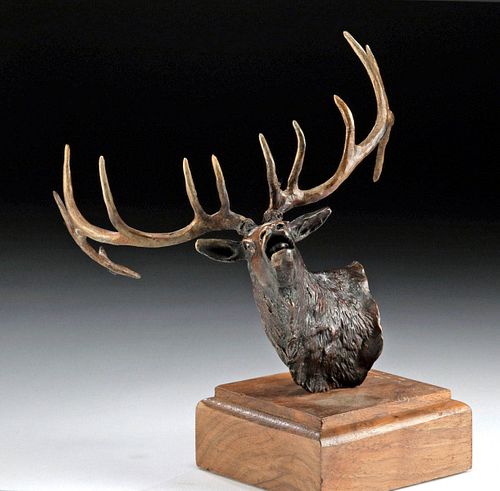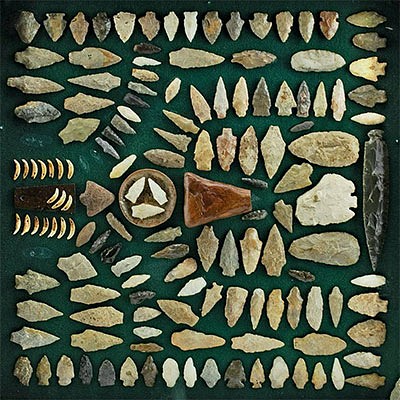John Scott Bronze Bust - "The Bull" (1995)
Lot 138
About Seller
Artemis Gallery
686 S Taylor Ave, Ste 106
Louisville, CO 80027
United States
Selling antiquities, ancient and ethnographic art online since 1993, Artemis Gallery specializes in Classical Antiquities (Egyptian, Greek, Roman, Near Eastern), Asian, Pre-Columbian, African / Tribal / Oceanographic art. Our extensive inventory includes pottery, stone, metal, wood, glass and textil...Read more
Estimate:
$600 - $900
Absentee vs Live bid
Two ways to bid:
- Leave a max absentee bid and the platform will bid on your behalf up to your maximum bid during the live auction.
- Bid live during the auction and your bids will be submitted real-time to the auctioneer.
Bid Increments
| Price | Bid Increment |
|---|---|
| $0 | $25 |
| $300 | $50 |
| $1,000 | $100 |
| $2,000 | $250 |
| $5,000 | $500 |
| $10,000 | $1,000 |
| $20,000 | $2,500 |
| $50,000 | $5,000 |
| $100,000 | $10,000 |
| $200,000 | $20,000 |
About Auction
By Artemis Gallery
Apr 28, 2022
Set Reminder
2022-04-28 12:00:00
2022-04-28 12:00:00
America/New_York
Bidsquare
Bidsquare : Art & Artifacts of North America
https://www.bidsquare.com/auctions/artemis-gallery/art-artifacts-of-north-america-9276
Join us for a special auction not to be missed! Collectible Native American art from two major collectors. Antiquity to mid-20th century! Plus fine & folk art, fossils, and more! All legally acquired. All legal to buy/sell. Convenient and professional in-house shipping. Artemis Gallery info@artemisgallery.com
Join us for a special auction not to be missed! Collectible Native American art from two major collectors. Antiquity to mid-20th century! Plus fine & folk art, fossils, and more! All legally acquired. All legal to buy/sell. Convenient and professional in-house shipping. Artemis Gallery info@artemisgallery.com
- Lot Description
John J. Scott (American, 1919-2016). "The Bull" silicon bronze, 1995. Inscribed with the artist's signature and ram symbol as well as the title of the piece and the edition number 14/250 on the back of the piece. Skillfully and meticulously cast via the lost wax process, "The Bull" demonstrates American sculptor John Scott's painstaking attention to the details of his majestic subject's anatomy as well as his deep respect and connection to wild life. This bull raises its head, boasts enormous antlers, opens its eyes wide, flares its nostrils, rotates its ears to listen, and with an open mouth, bellows a piercing bugle call to attract cows and demonstrate its dominance over other bulls. His message is loud and clear - all other bulls should steer clear, because this bull is ready to protect its domain! Size: 8" L x 8.125" W x 8.25" H (20.3 cm x 20.6 cm x 21 cm); 10.25" H (26 cm) on included custom stand.
John Scott was an American artist of Scottish heritage. He lived in a log cabin in the woods of Kittredge, Colorado that he built from the ground up and created sculptures and paintings inspired by the wildlife and scenery of Colorado and Wyoming. According to his wife Dorothy, "He was always working and always looking for something to throw himself into completely." Of note, John was immensely proud of his Scottish heritage, learned to play the bag pipes, and wore his Clan Scott tartan kilt. John was also an avid hunter of large game in Colorado and Wyoming as well as British Columbia and Alaska.
Not only did John build his log cabin which he called "Brig-O-Doon" - he also built and operated his own studio and foundry. John created his bronzes via the lost wax process, a method first used by the ancients. His technique involved 24 steps from the creation of the mold to pouring the hot bronze to welding the piece back together to the embellishing with finishing touches. Indeed, John's passion for his chosen profession was boundless; in his words, "Art is a monster that sweeps over me and it seems I never satisfy that creative spirit."
A little note on John Scott's signature ram symbol: Scott was greatly inspired by Charles Marion Russell whose emblem was a buffalo skull symbolizing his strong connection to the American West. Following in Russell's footsteps, Scott chose the ram as his symbol, because the Rocky Mountain bighorn ram with its massive curling horns is the state animal of his beloved Colorado. John Scott loved his homeland and his art has been exhibited throughout the American Southwest and beyond in reputable galleries of Colorado, New Mexico, Arizona, Texas, Nevada, and California.
Provenance: private John J. Scott Collection, Kittredge, Colorado, USA, acquired from the late John J. Scott
All items legal to buy/sell under U.S. Statute covering cultural patrimony Code 2600, CHAPTER 14, and are guaranteed to be as described or your money back.
A Certificate of Authenticity will accompany all winning bids.
PLEASE NOTE: Due to recent increases of shipments being seized by Australian & German customs (even for items with pre-UNESCO provenance), we will no longer ship most antiquities and ancient Chinese art to Australia & Germany. For categories of items that are acceptable to ship to Australia or Germany, please contact us directly or work with your local customs brokerage firm.
Display stands not described as included/custom in the item description are for photography purposes only and will not be included with the item upon shipping.
#170202Bronze bust is excellent and presents with a beautiful patina. Wooden base has minor scuffs, but is otherwise very nice. Bust is inscribed with the artist's signature and ram symbol as well as the title of the piece and the edition number 14/250 on the back of the piece. There is a Highlander Fine Art Studio label on the underside of the wooden base.Condition
- Shipping Info
-
All shipping is handled in-house for your convenience. Your invoice from Artemis Gallery will include shipping calculation instructions. If in doubt, please inquire BEFORE bidding for estimated shipping costs for individual items.
-
- Buyer's Premium



 EUR
EUR CAD
CAD AUD
AUD GBP
GBP MXN
MXN HKD
HKD CNY
CNY MYR
MYR SEK
SEK SGD
SGD CHF
CHF THB
THB















